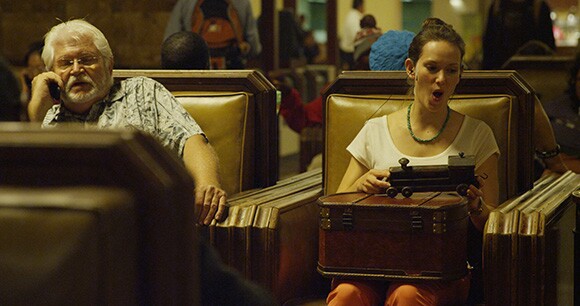Artbound Special Episode 'Invisible Cities'
Artbound presents a one hour special focused on the avant-garde opera, "Invisible Cities." Produced by The Industry, L.A.'s experimental opera company, in partnership with the L.A. Dance Project, "Invisible Cities" depicts the meeting between emperor Kublai Khan at the end of his life with the explorer Marco Polo, as told in Italo Calvino's fantastical book. An innovative production staged in the iconic Union Station, the opera utilizes wireless technology provided by Sennheiser, offering audience members headphones to hear the opera amid the normal "hustle and bustle" of the train station's everyday life. "Invisible Cities" is composed and adapted by Christopher Cerrone, directed by The Industry's founder and artistic director Yuval Sharon, with choreography by Danielle Agami.
View our online video series on "Invisible Cities" below:

Invisible Cities: The Dematerialization of the Opera
Artistic director Yuval Sharon details his inspiration for "Invisible Cities," and the endless possibilities opened up by the use of headphones. The presence of wireless technology in the experimental work creates a new operatic experience -- and maybe even expands the definition of opera.

Invisible Cities: The Science of a Silent Opera
Sound designer Martin Gimenez explains the challenges of getting wireless technology to deliver the extraordinary sonic experience that befits the unconventional opera.
Invisible Cities: Composing an Opera for Headphones
In composing the music for "Invisible Cities," Christopher Cerrone created many levels of orchestral detail that would evoke the elaborate and fantastical places that Calvino imagines.
Invisible Cities: The Choreography of Union Station
Dancers in "Invisible Cities" execute an array of moves in Union Station that range from rigorous solos to improvisational and hip-hop-like explosions, to glacially slow stances.
Finding Space in the Inferno: Observations on Calvino's 'Invisible Cities'
Union Station is an ideal place to realize the opera "Invisible Cities," an adaptation of Italo Calvino's book about relationships between built environments and social and economic life.
Dig this story? Sign up for our newsletter to get unique arts & culture stories and videos from across Southern California in your inbox. Also, follow Artbound on Facebook, Twitter, and Youtube.




